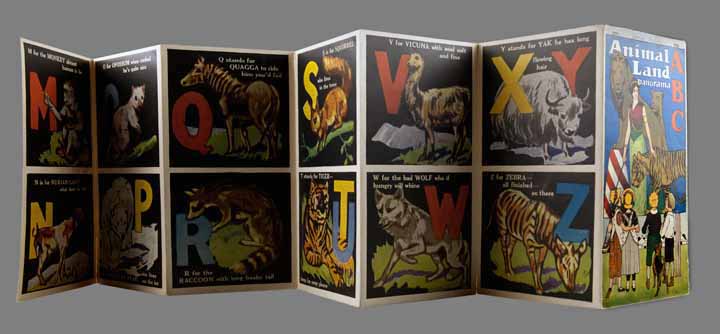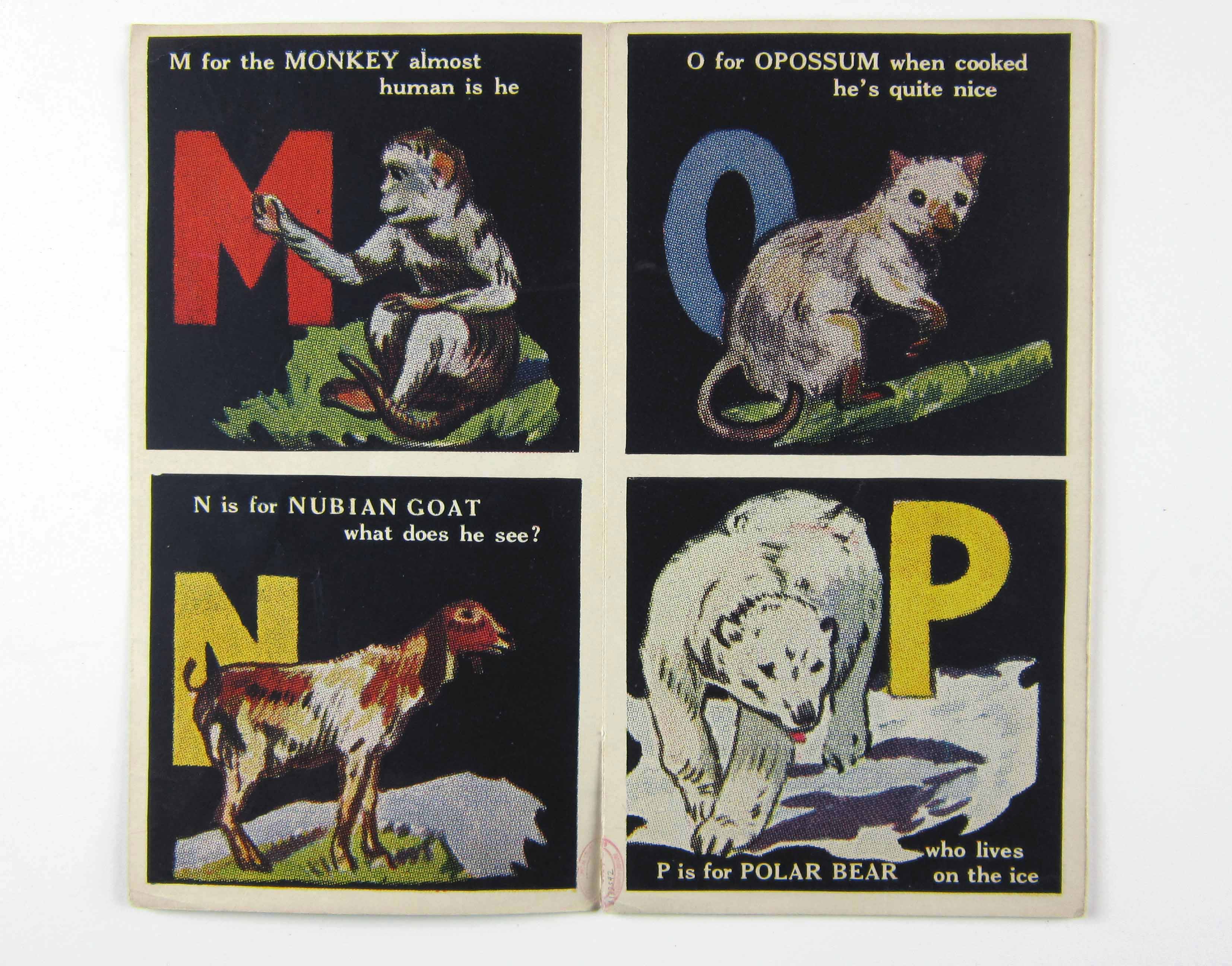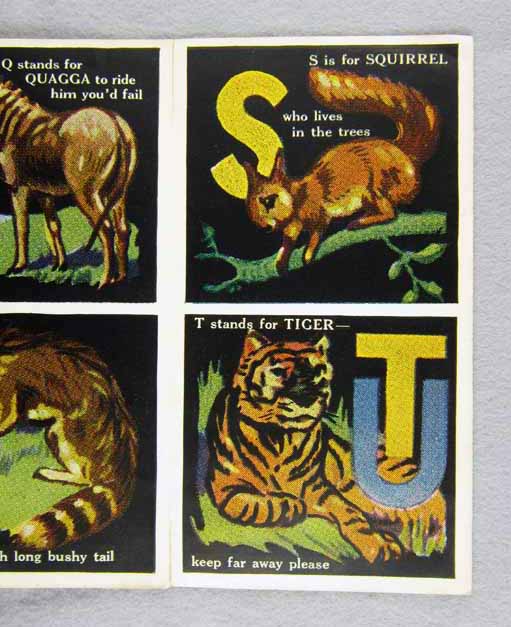

Alphabet books offer a vivid insight into the history of literacy and culture, as well as concepts of childhood. The Children's Book Collection at UCLA contains a rich array of these materials, some well-worn and much-used, some still bright and fresh. Each is a gem of print production and graphical imagery from another time and place. Though the history of alphabet books continues to the present, this exhibit focuses on the works in our collections published between 1700 and 1900, including horn books, primers, works of didacticism and seriousness, whimsy and play.
2. A Jumble ABC
3. A Little Pretty Pocket-Book
4. A New Lottery Book of Birds And Beasts
5. A Pretty Play-Thing for Children of All Denominations
8. ABC of Objects for Home And School
10. ABC with Pictures & Verses
12. Alphabet Et Instruction Pour Les Enfans
16. Dolly's ABC Book
17. Flora's ABC
18. Home ABC
22. Hornbook C. 1700
23. Large Letters for the Little Ones
24. Little ABC Book
25. Little People: An Alphabet
26. Martin's Nursery Battledoor
27. Mother Goose ABC
28. My Darling's ABC
29. Orbis Sensualium Pictus Quadrilinguis
30. People of All Nations: A Useful Toy for Girl Or Boy
31. Picture Alphabet
32. Pretty ABC
33. Railway ABC
34. Rusher's Reading Made Most Easy
38. The Alphabet of Old Friends
40. The Amusing Alphabet for Young Children Beginning To Read
42. The Child's Christian Education
45. The Easter Gift
47. The Favorite Alphabet for the Nursery
49. The Franklin Alphabet And Primer
51. The Golden ABC
55. The Moral And Entertaining Alphabet
57. The Old Testament Alphabet
59. The Picture Alphabet for Little Children
62. The Sunday ABC
63. The Union ABC
64. The Young Child's ABC, Or, First Book
65. Tom Thumb's Alphabet: Picture Baby-Books
67. Warne's Alphabet And Word Book: with Coloured Pictures
68. Wood's Royal Nursery Alphabet
Title Animal Land Panorama ABC





Brief description This is a panorama that folds open to 14 pages. The front wrapper and last wrapper are identical copies of the title page. Four school children are standing in front of a billboard that advertises a woman standing with several wild animals. Inside, there are two picture boxes to a page. Each box has a letter of the alphabet, a rhyme and a picture of the animal that characterizes the word. The panorama contains1 folder ([14] p.): colored illustrations. ; 25 x 93 cm. folds to 25 x 13 cm. There are illustrated self-wrappers. An Inscription on the upper wrapper says Bruce Melvin, 1900. New Orleans, La. Purchase, Robert Allen, 1992.
Full description The fold-out panorama viewed here is both a teaching tool and a delightful book for children. There are 7 double-sided panels with the title page at the first and last panels of the panorama. The title panel includes a picture of four schoolchildren, two girls and two boys with a dog, looking at a billboard of a circus act with the title of the book.
In the billboard, a woman in a long skirt stands with a tiger in front of her. There is a lion posing on a red and white spiraled stand beside her and a lioness staring forward behind her. The female school children are wearing long dresses, straw hats with flowers and aprons. One girl is obviously holding a strap over her arm that is attached to several schoolbooks. The two boys are wearing long shorts, brown shoes and one is wearing a cap. The boys are standing slightly to the right in a pair while the girls are holding each other slightly to the left.
Each of the other pages contains two boxes, one on top of the other, with one letter to a box. In alphabetic order, the child is provided with a letter, a rhyme and a picture. The first top square is for the letter A." A is for ANTELOPE" and alphabet too, begins the rhyme, with a picture of a relatively accurate drawing of an antelope standing next to a large, capital A. Only capital letters are provided in the large alphabet next to the pictures.
It is interesting to note that the word associated with each letter is in all capitals while the rest of the rhyme is in small letters. Also, note that the rhyme includes contractions like he'd and you'll. The animals used are as followed: Antelope, Bear, Camel, Deer, Elephant, Fox, Giraffe, Hippopotamus, Ibex, Jaguar, Kangaroo, Lion, Monkey, Nubian Goat, Opossum, Polar Bear, Quagga, Raccoon, Squirrel, Tiger, Vicuna, Wolf, Yak and Zebra.
Also, it is interesting that X and Y are located in the same box above Z, but only Y is illustrated in the box with the word Yac. X is omitted from the illustrations and rhyme save for a brightly colored large X that stands in the same box as the Yac. Similarly, U and T stand in the same box, through only T is provided with a picture and rhyme. The drawings also appear to be fairly accurate. The final panel on the back of the panorama is the exact copy of the title page.
Literacy By the 1900s, a highly literate society had developed and it became important to capture the imagination of young children with bright colors, large type, and exotic pictures to maintain their interest. This example is a panorama, which folds out into several panels.
Since the New England Premier's alphabet, the image-rhyme pairs have been somewhat of a standard procedure for teaching children their letters, regardless of how the content has changed. This sort of layout allows children to comprehend each page without the strict discipline of reading. Even the idle child would discover that it is relatively easy to memorize the verses after a few repetitions.
This particular item uses animals to promote the memorization of the alphabet. "A is for ANTELOPE" and alphabet too, begins the rhyme, with a picture of a relatively accurate drawing of an antelope standing next to a large, capital A. The A anchors the image to the letter, which aids the child in associating the word, image and letter together.
This example both demonstrates the alphabet's position between oral and literate modes, and between image and text. The animals chosen are interesting selections because they include animals that are not normally seen by the children reading this book. There are even exceptionally odd choices, such as the ibex, quagga, and vicuna.
Childhood The cover of this book illustrates the target audience of this panorama. Young girls in long skirts and carrying school books stand next to two boys in long shorts who also holding school books. They marvel over a poster of wild animals from a circus on the way to or from school.
From this title page, it is obvious that both female and male children attend school and they are both required to master their letters. Thus, the cover strongly suggests that the fold-out book was made for both female and male audiences. Despite this, the way each gender is represented is quite distinct.
The two girls affectionately grasp one another while the two boys stand slightly apart from the girls and even one another. The dog further completes the picture by standing closer to his young master. The dog represents the world outside of the home, where there is dirt and danger. The girls, however, wear their aprons and hats to protect themselves from the dirt and sun of the outside world until their return to their homes.
Their clothes do not appear to be tattered or especially well-made, which suggests that these are middle class children. Thus, both genders are expected to attend school and learn their letters; however, there are also accepted roles for each child contingent upon their gender and the possible economic position of their families.
Iconography The children standing in front of the sign are students. It is obvious from their books and postures that they have paused on the way to their school to gaze up at the brightly colored sign of marvelous wild animals. The entire scene has been constructed to be suitable for the culture of the early twentieth century.
While both female and male students are expected to become literate by this period, there is still an obvious separation of genders. The two girls look very sweet with their long skirts, modest hats and gentle embrace. The boys, on the other hand, stand apart from the two girls and each other. The dog stands in between the boys, obediently watching one boy in particular. All of these children know the behavior expected of them, and their depictions on the cover further reinforce these ideals for the children who read this book.
The theme and vocabulary of this panoramic book also provide an indication of the cultural iconography of the early twentieth century. The scope of children's literature has progressed considerably since the chiefly religious and moral texts of the eighteenth century. Instead, the wild and exotic animals chosen to characterize each letter of the alphabet are for the amusement of the young readers. While the rhyme itself appears to be chosen to suit a young age group learning their letters, the vocabulary of animals can be quite difficult.
For example, the author chose to characterize H with a hippopotamus, Q for a quagga and V for vicuna. These choices were likely contingent upon the uniqueness of those letters in the primary location in a word. The necessity of finding words that begun with each letter proved more important than finding vocabulary suited for a young mind. Moreover, the scope of the animals included in the vocabulary demonstrates that the public has become more informed on the animals of other countries by the twentieth century. The accuracy of the drawings also attest to this because not only is there enough knowledge upon the existence of the animals, but there is also knowledge on their anatomy.
Youths are introduced to animals far beyond the borders of their homes from early childhood in order to broaden their horizons early in life.
Production By 1900, children's literature had entered into a golden age for publishers. Indeed, reading had become central to the American culture and children's books in particular were a steady source of income for publishers. Panoramic books had become fairly popular by the beginning of the twentieth century.
Unfortunately, this book lacks the exact copyright dates and publisher information. There is an inscription located on the front title page, with the words "Bruce Melvin, 1900. New Orleans, La. Purchase, Robert Allen, 1992." These words, however, most likely indicate ownership rather than publishing information. Other rare copies of this panorama lack this handwritten inscription.
Publisher Unknown
Date 1900
UCLA Call Number Z1033.T689 A5444 1900
Repository UCLA Charles E. Young Research Library, Dept. of Special Collections
Dimensions 25 cm x 93 cm, folds to 25 cm x 13 cm
Media and Materials Paper
Additional Information Inscription: Bruce Melvin, 1900. New Orleans, La. Purchase, Robert Allen, 1992
Caption